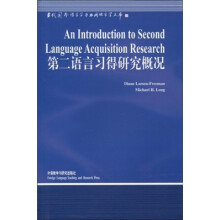Preface by Hallday
General Editors Preface
Authors Preface
Acknowledgements
1 Introduction
1.1 The place of second language in the world today
1.2 Why study second language acquisition?
1.3 Development of the field of study of second language acquisition
1.4 The scope of second lanb, uage acquisition research
Notes
Activities
Suggestions for further reading
2 Second language acquisition research methodology
2.1 Introduction
2.2 Qualitative versus quantitative methodologies
2.2.1 Introspection
2.2.2 Participant observatiorf
2.2.3 Non-participant observation
2.2.4 Focused description
2.2.5 Pre-experiment
2.2.6 Quasi-experimem
2.2.7 Experiment
2.3 Setting
2.4 Instrumentation: production data elicitation
2.5 Variability problem
2.6 Instrumentation: intuitional data elicitation
2.7 Instrumentation: use of miniature,languages
2.8 Instrumentation: affective variables
2.9 Instruments from other disciplines
2.10 Measuring learner performance
2.10.1 Defining language proficiency
2.10.2 Defining an acquisition point
2.10.3 Taskversus test
2.10.4 An index of development
2.11 Conclusion
Notes
Activities
Suggestions for further reading
3 SLA: Types of data analysis
3.1 Introduction
3.2 Contrastive analysis
3.2.1 The contrastive analysis hypothesis
3.2.2 Language acquisition as habit formation
3.2.3 The CAH refuted
3.3 Error analysis
3.3.1 Strong versus weak Versions of the CAH
3.3.2 Language acquisition as rule formation
3.3.3 Interlingual versus intralingual errors
3.3.4 Interlanguage
3.3.5 Error analysis criticized
3.4 Performance analysis
3.4.1 Morpheme studies
3.4.2 Developmental sequence
3.4.3 Learner strategies
3.4.4 The acquisition of forms and functions
3.4.5 Formulaic utterances
3.5 Discourse analysis
3.5.1 Conversational analysis
3.5.2 Other applications of discourse analysis
3.6 Conclusion
Notes
Activities
Suggestions for further reading
4 Interlanguage studies: Substantive fmdings
4.1 Introduction
4.2 ILs vary systematically
4.2.1 Free variation
4.2.2 Systematic vatriability
4.2.3 Variability resulting from amount of attention
4.2.4 Free variation as an impetus for development
4.2.5 Multiple explanations for variability
4.3 ILs exhibit common acquisition orders and developmental sequences
4.3.1 Acquisition order: morpheme studies
4.3.2 Developmental sequence: interrogatives
4.3.3 Developmental sequence: negation
4.4 ILs are influenced by the learners L1
4.4.1 The effect of the L1 on SLA: how
4.4.2 The effect of the L1 on SLA: when (markedness)
4.4.3 The effect of the L1 on SLA: when (perceived transferability)
Notes
Activities
Suggestions for further reading
5 The linguistic environment for language acquisition
5.1 Linguistic input for first language acquisition
5.2 Linguistic input for second language acquisition
5.2.1 Linguistic adjustments to non-native speakers
5.2.2 Conversational adjustments to non-native speakers
5.3 Does the linguistic environment make a difference?
5.3.1 The effect of deviant input
5.3.2 The role of conversation in developing syntax
5.3.3 Input frequency-accuracy order relationships
5.3.4 Input modification and second languagecomprehension
5.3.5 Comprehensible input and second language
acquisition
Notes
Activities
Suggestions for further reading
6 Explanations for differential success among second language learners
6.1 Introduction
6.2 Age
6.2.1 Studies of age and SLA
6.2.2 Explanations for age-related differences
6.3 Aptitude
6.4 Social-psychological factors
6.4.1 Motivation
6.4.2 Attitude
6.5 Personality
6.6 Cognitive style
6.7 Hemisphere specialization
6.8 Learning strategies
6.9 Other factors
6.10 Conclusion
Notes
Activities
Suggestions for further reading
7 Theories in second language acquisition
7.1 Introduction
7.2 Theory construction and social science
7.2.1 The role of theories in making research cumulative
7.2.2 Purposes a~d types of theory
7.3 Nativist theories of SLA
7.3.1 General characteristics
7.3.2 Chomskys Universal Grammar and SLA
7.3.3 A critique of language-specific nativist theories
7.3.4 Krashens Monitor Theory
7.3.5 A critique of Monitor Theory
7.4 Environmentalist theories of SLA
7.4.1 General characteristics
7.4,2 Schumanns Pidginization Hypothesis and Acculturation Model
7.4.3 A critique of the Pidginization Hypothesis and Acculturation Model
7.5 Interactionisttheories of SLA
7.5.1 General characteristics
7.5.2 Givons Functional-Typological Theory and SLA
7.5.3 A critique of Givons theory in SLA research
7.5.4 The ZISAs groups Multidimensional Model
7.5.5 A critique of the Multidimensional Model
7.6 Conclusion: the state of SLA theories
7.6.1 Comparing and evaluating theories
7.6.2 A note of caution
Notes
Activities
Suggestions for further reading
8 Instructed second language acquisition
8.1 Introduction
8.2 Early research on the effect of instruction, and some claimed implications
8.3 The effect of instruction on accuracy orders and developmental sequences
8.4 The effect of instruction on acquisition processes
8.5 The effect of instruction on rate of acquisition
8.6 The effect of instruction on the level of ultimate SL attainment
8.7 Conclusion
8.8 Explanations
8.9 Researching instructional design features
Notes
Activities
Suggestions for further reading
Epilogue
Bibliography
Index

 缺书网
缺书网 扫码进群
扫码进群






